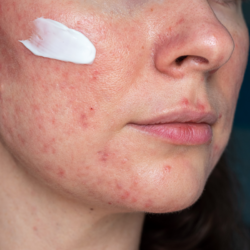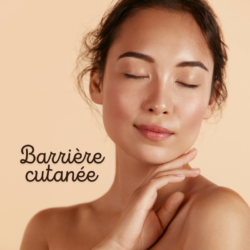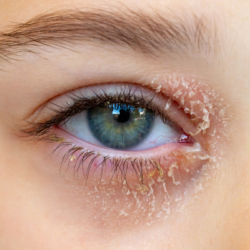Wild pansy has a long tradition of use in traditional medicine and herbal medicine. Preparations are made from the aerial part of the plant, harvested during the flowering period. It contains 0.3% salicylic acid and its derivatives, as well as phenolcarboxylic acids, mucilages, tannins, flavonoids, carotenoids, coumarins, umbelliferone, saponins, ascorbic acid and tocopherol.
In the United States, it is commonly used in the form of creams to treat eczema, and is taken orally for acute bronchitis. In traditional medicine, wild pansy is used for its depurative, diuretic, cholagogue-choleretic and diaphoretic properties. It is also sometimes used to relieve nightmares, insomnia and sleep disorders involving frequent waking.
What are the effects of wild pansy on the skin?
Wild pansy is renowned for its dermatological benefits, both externally and orally. This plant offers genuine natural benefits for the skin, helping to purify it, eliminate microbes, regulate skin pH and control excess sebum.
Although the first scientific publications on the dermatological activity of wild pansy date back to 1883(Köhler), it was not until 1938 that research demonstrated its therapeutic activity in an eczema model, with evidence of an improvement in skin disorders after adding fresh wild pansy to the diet for 2 months, compared with a control group. Since then, a number of publications (the most recent dating from 2009) have mentioned the value of Viola tricolor in the treatment of various skin disorders, including seborrhoeic conditions, impetigo, acne and pruritus, vulvar irritation and itching, skin rashes, eczema, seborrhoea of the scalp in newborns, and psoriasis.
The depurative and purifying properties of its flowers and aerial flowering parts make it a natural remedy frequently used in phytotherapy to improve skin health and treat common skin ailments. Viola tricolor preparations have antimicrobial activity, the most effective being aqueous and alcoholic extractions. These have shown a significant inhibitory effect against Staphylococcus aureus, Bacillus cereus, Staphylococcus epidermidis and Candida albicans, and a moderate effect against Pseudomonas aeruginosa, Enterococcus faecalis, Escherichia coli and Klebsiella pneumoniae. The least effective preparations are those with high molecular selectivity, suggesting a synergistic action of the different components present in the other extractions. Cyclotides in particular are responsible for this effect.
What are the antioxidant and immune effects of Viola tricolor?
Using the TEAC method, a hydroalcoholic extract of fresh wild pansy leaves or flowers showed antioxidant activity at least equivalent to that of a plant known for its antioxidant properties, such as ginkgo biloba. More recently, two methods (TEAC and DPPH) used to assess the antioxidant power of different wild pansy extraction fractions have shown that polar components have better activity, including flavonoids such as rutin and violanthin.
Using the high-performance liquid chromatography (HPLC) method, which proved to be linear, sensitive, precise, specific and robust for quantifying rutin in wild pansy extract, it was shown that the antioxidant capacity of Viola tricolorcan be attributed to the large quantities of polyphenols, flavonoids and condensed tannins it contains.
In an in vitro model of ischaemia and neurodegeneration, the hydroalcoholic extract of V. tricolor protects neurons against cell death induced by serum/glucose deprivation. This activity is attributed, at least in part, to its antioxidant properties against reactive oxygen species (ROS).
Aqueous extract of wild pansy is immunosuppressive, an activity attributed to its cytoclides, with well-identified cytotoxic properties, which interfere with the polyfunctionality of T lymphocytes and block the proliferation of immunocompetent cells. More specifically, they inhibit the proliferation of activated lymphocytes by reducing the secretion of IL-2 cytokines without affecting the expression of the interleukin-2 (IL-2) receptor, and by reducing the production of gamma interferon (IFN-y) and tumour necrosis factor alpha (TNF-α).
V. tricolor has potential anticancer activity by inducing apoptosis, as demonstrated by the action of different types of plant extracts studied on mouse neuroblastoma and human breast cancer cells. It also has the ability to inhibit angiogenesis.
Does Viola tricolor have anti-inflammatory properties?
In a model of acute inflammation, the effect of administering wild pansy mother tincture was evaluated. Although its effects were moderate compared with a reference anti-inflammatory, wild pansy significantly reduced the number of leukocytes, the number of phagocytes and their activity, as well as the production of nitric oxide (NO) compared with the control group.
In a model of solar erythema, a gel based on Viola tricolor showed an antinociceptive and anti-inflammatory effect on UV-B-induced burns, by maintaining the temperature below 25°C.
In vivo, in a model of chronic asthma, a hydroalcoholic extract of Viola tricolor flowers showed anti-inflammatory effects, via inhibition of type 2 (Th2) cytokine production, which seems to validate its empirical use in traditional medicine.
What other benefits does wild pansy provide?
Wild pansy has a wide range of therapeutic applications. Its diuretic properties are beneficial for relieving cystitis by encouraging the elimination of chlorides, while acting as a mild laxative beneficial for digestive disorders. It relieves pain associated with rheumatism thanks to its mild analgesic and antispasmodic properties.
In the case of coughs accompanying respiratory conditions characterised by excessive mucus secretion, wild pansy acts as an expectorant, soothing coughs due to conditions such as bronchitis, whooping cough and other similar problems. In the field of respiratory ailments, wild pansy is recommended for treating inflammation of the mucous membranes of the respiratory tract, particularly when associated with hypersecretion, as in the case of asthma, acute bronchitis, whooping cough and tracheitis.
Wild pansy can also have soothing effects on nervousness,insomnia and sleep disorders associated with nightmares. Externally, it can be used as a mouthwash for oral hygiene and as a hair lotion to control greasy hair. It can also be beneficial for circulatory problems such as varicose veins and haemorrhoidal attacks.
As far as urinary problems are concerned, wild pansy can be used to treat conditions such as nephritis and renal colic. Finally, studies have shown that wild pansy can have a positive effect in reducing inflammation caused by excessive exposure to UVB rays.
How should Wild Pansy be taken and at what dosage?
Wild pansy is harvested in its natural environment, far from agricultural areas treated with plant protection products. The ideal time to pick pansy is during its flowering period, generally from April to September. It is essential to take precautions to prevent the flowers losing their colour. This means picking early in the morning and drying quickly, away from excessive heat and strong sunlight.
Wild pansy is also available from chemists and herbalists. It can be used in a variety of ways. When taken as a food supplement, the recommended dosage for wild pansy powder is generally between 270 and 800 mg per day. However, this dosage may vary depending on the product and extract used. What’s more, the dosage may be different when wild pansy is combined with other natural extracts. It is therefore important to follow the specific recommendations of the product you are using.
- As a dietary supplement, in the form of wild pansy powder in capsules.
- Standardised fresh plant fluid extract for officinal preparation: 5 to 10 ml per day in a glass of water.
- Honeyed fluid extract of wild pansy: 5 ml twice a day in water.
- Wild pansy infusion: 1 to 2 spoonfuls of dried aerial flowering parts, infuse for 10 minutes, 1 cup 1 to 3 times a day.
- Wild pansy hydroalcoholic extract: 20 to 40 drops 2 to 3 times a day in a glass of water.
What are the side effects and contraindications of wild pansy?
Wild pansy should not be used on open wounds or severely damaged areas of skin. In 2010, the European Medicines Agency (EMA) did not recommend the use of wild pansy in pregnant women, breast-feeding women and children under the age of 12, due to a lack of sufficient data.
Due to the presence of coumarins and salicylates, wild pansy should be used with caution in people taking anticoagulants, as it may have additive effects. Patients should be monitored clinically and have their INR checked. It is important to note that wild pansy root can cause vomiting, as can violet root.
Pansy-based food supplements are not recommended for pregnant women, breast-feeding women or children. They are also contraindicated for people with extensive dermatological conditions or open wounds. If in doubt, and before starting a phytotherapeutic cure, it is advisable to seek advice from a health professional.
Apart from the contraindications mentioned above, no major side-effects have been reported with the use of wild pansy. Wild pansy may interact with certain antihypertensive drugs. It is therefore advisable to consult a healthcare professional before starting a treatment based on wild pansy.





